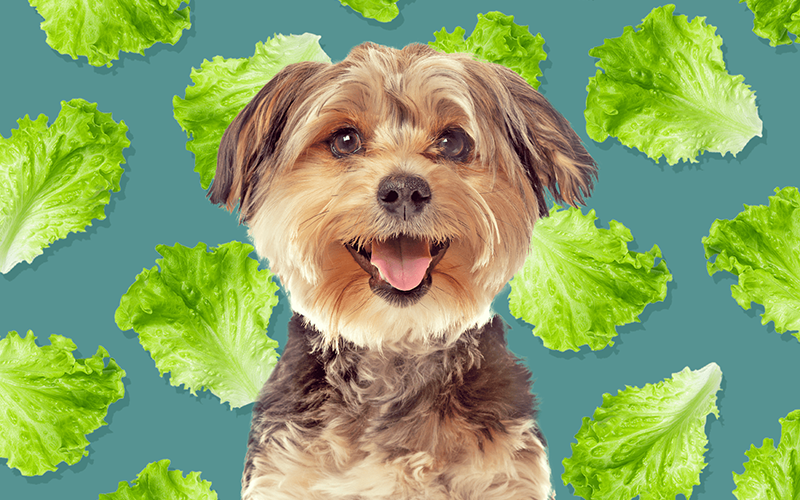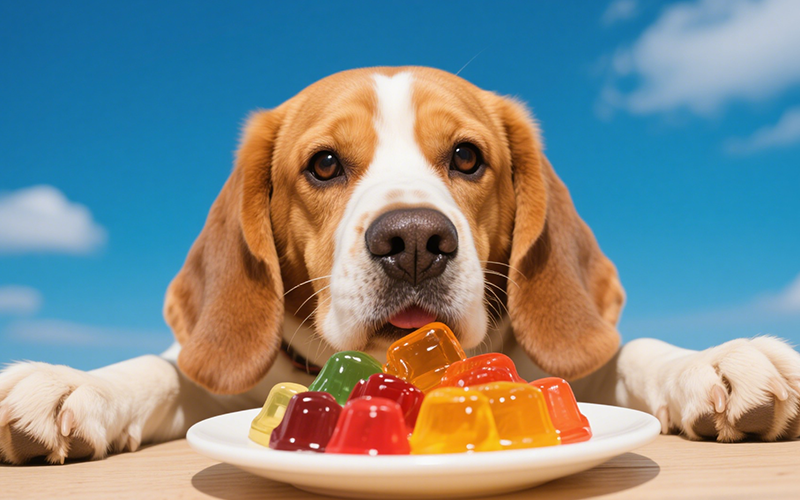Can Dogs Eat Lettuce? Exploring the Benefits and Risks of Feeding Lettuce to Your Dog
- 20 Feb 2025 11:43
As pet owners, we often want to share healthy snacks with our dogs, and vegetables can be an excellent choice. Lettuce is one such vegetable that many people consider feeding to their dogs. But can dogs eat lettuce safely? The good news is that lettuce is not toxic to dogs and can be a healthy treat when served properly. However, there are a few things you should know before offering it to your dog. Let’s dive into the benefits, risks, and tips for feeding lettuce to your furry friend.

The Nutritional Benefits of Lettuce for Dogs
Lettuce is a low-calorie, crunchy vegetable that’s rich in water and can offer some health benefits to your dog. Here are some of the nutrients lettuce provides:
Low in Calories and Fat
Lettuce is very low in calories and fat, making it an ideal snack for dogs that are on a diet or need to maintain a healthy weight. It’s a good alternative to calorie-dense treats, as it can satisfy your dog’s need for a crunchy snack without adding extra weight.High Water Content
Lettuce has a high water content, which can help keep your dog hydrated, especially during the warmer months. It can be a great addition to your dog’s diet for a little extra hydration, especially if your dog isn’t drinking enough water on its own.Rich in Fiber
Lettuce contains fiber, which can aid in digestion and help regulate your dog’s bowel movements. Fiber can also promote a feeling of fullness, which may help prevent overeating or excessive snacking between meals.Vitamins and Minerals
Lettuce contains small amounts of important vitamins and minerals, including vitamin A, vitamin K, and folate. These nutrients support your dog’s overall health, from maintaining good vision to promoting healthy skin and bones.
Risks of Feeding Lettuce to Dogs
While lettuce is generally safe for dogs to eat in moderation, there are a few risks and considerations to keep in mind:
Digestive Upset
Lettuce is mostly water and fiber, so too much of it can potentially cause digestive upset in some dogs. If your dog is not used to eating vegetables or has a sensitive stomach, large amounts of lettuce could lead to diarrhea or bloating. It’s best to introduce lettuce gradually and in small amounts to see how your dog reacts.Choking Hazard
For small dogs or dogs that tend to gulp their food, large pieces of lettuce could pose a choking hazard. Always make sure to tear lettuce into small, manageable pieces before offering it to your dog. If your dog is a particularly fast eater, consider giving them lettuce in a puzzle feeder or mixing it with their regular food to slow them down.Nutrient Absorption
While lettuce contains some vitamins and minerals, it’s not particularly nutrient-dense compared to other vegetables. For example, while it provides vitamin A, it doesn’t have as much as carrots or sweet potatoes. Therefore, lettuce should not be the main source of vegetables in your dog’s diet but rather an occasional treat alongside other more nutrient-dense options.Lettuce Varieties
Not all types of lettuce are created equal. Iceberg lettuce, while commonly found in salads, has very little nutritional value and may cause digestive upset if consumed in large amounts due to its high water content. On the other hand, romaine lettuce is a healthier option with more nutrients and fiber. Always choose a variety that’s lower in water content and richer in fiber and nutrients, like romaine, when feeding lettuce to your dog.
How to Safely Serve Lettuce to Your Dog
If you decide to share lettuce with your dog, here are some tips to ensure that it’s a safe and enjoyable treat:
Wash Thoroughly
Always wash lettuce thoroughly before serving it to your dog to remove any dirt, pesticides, or chemicals that may be on the leaves. Organic lettuce is a good choice if you're concerned about chemicals, but washing it properly is still important.Serve in Small Pieces
Tear the lettuce into small, manageable pieces to prevent choking. If your dog is small or a fast eater, make sure to break the lettuce into even smaller bits to avoid any risks of swallowing it whole.Avoid Seasonings
Never serve lettuce with any seasoning, dressings, or sauces, as many of these can contain harmful ingredients like salt, garlic, or onion, which are toxic to dogs. Stick to plain lettuce to keep things safe for your pet.Introduce Slowly
If your dog has never had lettuce before, introduce it in small amounts and observe their reaction. Start with just a leaf or two and monitor for any signs of digestive upset or allergies, such as vomiting, diarrhea, or bloating.Balance with Other Vegetables
Lettuce should be treated as a treat or a supplement to your dog’s regular diet, not a staple. Offer other, more nutrient-dense vegetables such as carrots, green beans, or sweet potatoes alongside lettuce for a well-rounded treat.
Can Lettuce Help with Weight Loss in Dogs?
Because lettuce is low in calories and high in fiber, it can be a good option for dogs who need to lose weight or maintain a healthy weight. If you’re working on managing your dog’s weight, replacing high-calorie treats with lettuce can help them feel full without consuming extra calories. It’s also a great way to add variety to your dog’s snack routine without overloading them with fat or sugar.
Alternatives to Lettuce for Dogs
If you’re looking for other healthy snacks to share with your dog, there are plenty of vegetables and fruits that are safe and nutritious. Here are some options:
Carrots – Crunchy and packed with beta-carotene, carrots are a healthy, low-calorie snack that most dogs love.
Green Beans – Full of fiber and low in calories, green beans are a great option for dogs who need to watch their weight.
Sweet Potatoes – Rich in vitamins A and C, and fiber, sweet potatoes are a tasty and nutritious treat for dogs.
Cucumber – Like lettuce, cucumber is low in calories and high in water, making it a refreshing treat for dogs on a hot day.
Spinach – Packed with iron and vitamins, spinach is a good alternative to lettuce for providing extra nutrients to your dog.
The Role of PettureX in Tracking Your Dog’s Health
If you're ever uncertain about what foods are safe for your dog, or if you're monitoring your dog’s diet to ensure they’re eating the right things, tools like PettureX can be a valuable resource. PettureX offers 24-hour online consultation, allowing you to ask questions about your dog’s diet, potential food allergies, and health concerns in real-time. The software also includes a pet image recognition tool to help track changes in your dog’s health, making it easier to spot any potential issues early.
Conclusion: Can Dogs Eat Lettuce?
So, can dogs eat lettuce? Yes, they can! Lettuce is generally safe for dogs to eat in moderation and can be a refreshing, low-calorie snack. It offers hydration, fiber, and a few essential nutrients but should not be the primary vegetable in your dog’s diet. Stick to varieties like romaine lettuce, wash it thoroughly, and serve it in small, manageable pieces to avoid choking hazards. Always monitor your dog’s reaction when introducing new foods and consult a pet health assistant like PettureX if you have any concerns about your dog's diet.
By offering lettuce as an occasional treat alongside other healthy options, you can provide your dog with a tasty snack that promotes hydration and overall health while ensuring they stay happy and safe.
Related

Can Dogs Eat Peaches? Vet Explains Benefits, Cyanide Risks & Safe Serving
- 16 Apr 2025
Can Dogs Eat Mulberries? Vet Explains Safety, Benefits & Potential Risks
- 16 Apr 2025
Can Dogs Eat Mozzarella? Vet Explains the Cheesy Truth (Risks & Benefits)
- 16 Apr 2025
Can Dogs Eat Mango Skin? Vet Explains Why It's a Risky Chew!
- 16 Apr 2025
Can Dogs Eat Maple Syrup? The Sugary Truth & Why Vets Advise Against It
- 16 Apr 2025
Can Dogs Eat Mac n Cheese? Vet Explains Why This Comfort Food Is Unsafe!
- 16 Apr 2025
Can Dogs Eat Liver? Vet Guide to This Nutrient-Dense Organ Meat (Benefits & Risks!)
- 16 Apr 2025
Can Dogs Eat Licorice? The Sweet Danger & Glycyrrhizin Risk Explained by Vets
- 16 Apr 2025
Can Dogs Eat Lamb? Vet Insights on This Nutritious Meat Option
- 16 Apr 2025
Can Dogs Eat Jelly? The Sweet Truth About Sugar, Xylitol & Why Vets Say No!
- 16 Apr 2025
